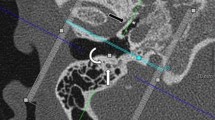Abstract
Purpose
Iatrogenic injury of the chorda tympani is a well-known complication of middle ear surgery, yet few studies have investigated the intraosseous course of the nerve. The aim of this study was to accurately delineate the posterior canaliculus in the temporal bone, particularly its relationship to the tympanic annulus, which is critical during the insertion of subannular ventilation tubes.
Methods
Forty temporal bones from 27 cadavers (15 male, mean age 75 years, 13 bilateral) were scanned using a micro-CT scanner, and standardised 3-D multiplanar reconstructions were generated using a software platform. The posterior canaliculus was measured in relation to reproducible bony landmarks.
Results
In 6 (15%) specimens, the chorda tympani originated from the facial nerve outside the skull and in 34 (85%) from within the facial canal at a mean of 3.2 ± 1.8 mm above the stylomastoid foramen. The posterior canaliculus was 12.3 ± 3.8 mm long and converged on the tympanic sulcus cranially. It entered the middle ear at 62 ± 10% of the height of the tympanic membrane.
Conclusions
This novel micro-CT study defines the precise anatomy of the posterior canaliculus housing the chorda tympani and provides data that may help the otologic surgeon protect the nerve from iatrogenic injury.



Similar content being viewed by others
References
Altman F (1949) Problem of so-called congenital atresia of the ear. Arch Otolaryngol Head Neck Surg 50(6):759–788
Anson BJ, Donaldson JA, Shilling BB (1972) Surgical anatomy of the chorda tympani. Ann Otol Rhinol Laryngol 81(5):616–631
Bettman RHR, Appelman AM, Van Olphen AF, Zonneveld FW, Huizing EH (2003) Cochlear orientation and dimensions of the facial recess in cochlear implantation. ORL J Otorhinolaryngol Relat Spec 65(6):353–358
Bielamowicz SA, Coker NJ, Jenkins HA, Igarashi M (1988) Surgical dimensions of the facial recess in adults and children. Arch Otolaryngol Head Neck Surg 114(5):534–537
Blanks RHI, Curthoys IS, Markham CH (1975) Planar relationships of the semicircular canals in man. Acta Otolaryngol 80(1):185–196
Daudia A, Yelavich S, Dawes PJD (2010) Long-term middle-ear ventilation with subannular tubes. J Laryngol Otol 124(9):945–949
Della Santina CC, Potyagaylo V, Migliaccio AA, Minor LB, Carey JP (2005) Orientation of human semicircular canals measured by three-dimensional multiplanar CT reconstruction. J Assoc Res Otolaryngol 6(3):191–206
Durcan DJ, Shea JJ, Sleeckx JP (1967) Bifurcation of the facial nerve. Arch Otolaryngol Head Neck Surg 86(6):619–631
Eby TL (1996) Development of the facial recess: implications for cochlear implantation. Laryngoscope 106(5 Part 2 Suppl 80):1–7
Fujita S, Nakashima S, Sando I, Takahashi H (1994) Postnatal developmental changes in facial nerve morphology. Computer-aided 3-D reconstruction and measurement. Eur Arch Otorhinolaryngol 251(7):434–438
Hamamoto M, Murakami G, Kataura A (2000) Topographical relationships among the facial nerve, chorda tympani nerve and round window with special reference to the approach route for cochlear implant surgery. Clin Anat 13(4):251–256
Jeppsson PH (1967) Studies on the innervation of taste buds. Acta Otolaryngol Supplement 224:140–148
Kulczynski B, Wozniak W (1978) Variation of the origin and course of the chorda tympani. Folia Morphol 37(3):237–241
Kullman GL, Dyck PJ, Cody DT (1971) Anatomy of the mastoid portion of the facial nerve. Arch Otolaryngol Head Neck Surg 93(1):29–33
Low WK (1999) Surgical anatomy of the facial nerve in Chinese mastoids. ORL J Otorhinolaryngol Relat Spec 61(6):341–344
McManus LJ, Dawes PJ, Stringer MD (2011) Clinical anatomy of the chorda tympani: a systematic review. J Laryngol Otol 125(11):1101–1108
McManus LJ, Stringer MD, Dawes PJ (2012) Iatrogenic injury of the chorda tympani: a systematic review. J Laryngol Otol 126(1):8–14
Michael P, Raut V (2007) Chorda tympani injury: operative findings and postoperative symptoms. Otolaryngol Head Neck Surg 136(6):978–981
Muren C, Wadin K, Wilbrand HF (1990) Anatomic variations of the chorda tympani canal. Acta Otolaryngol 110(3–4):262–265
Proctor B, Nager GT (1982) The facial canal: normal anatomy, variations and anomalies. Ann Otol Rhinol Laryngol Supplement 97:33–44
Saito R, Watanabe S, Fujita A, Fujimoto A, Inokuchi I, Ogura Y (1985) Temporal bone pathology in congenital anomalies of the oval window and the facial nerve. Auris Nasus Larynx 12(3):139–148
Saito T, Manabe Y, Shibamori Y et al (2001) Long-term follow-up results of electrogustometry and subjective taste disorder after middle ear surgery. Laryngoscope 111(11 Pt 1):2064–2070
Su W, Marion MS, Hinojosa R, Matz GJ (1982) Anatomical measurements of the cochlear aqueduct, round window membrane, round window niche, and facial recess. Laryngoscope 92(5):483–486
Wright A, Valentine P (2008) The anatomy and embryology of the external and middle ear. In: Gleeson M (ed) Scott-Brown’s otorhinolaryngology, head and neck surgery, 7th edn. Hodder Arnold, London, pp 3105–3125
Yasumura S, Takahashi H, Sando I, Aoki H, Hirsch BE (1993) Facial nerve near the external auditory meatus in man: computer reconstruction study—preliminary report. Laryngoscope 103(9):1043–1047
Young Y, Nadol JB (1989) Dimensions of the extended facial recess. Ann Otol Rhinol Laryngol 98(5):336–338
Acknowledgments
We wish to thank Andrew McNaughton, Otago Centre for Confocal Microscopy, for his expertise with micro-CT scanning and James Liley and Dr. Gerrard Liddell for their help with the mathematical algorithm that enabled calculation of Reid’s planes.
Conflict of interest
The authors declare that they have no conflict of interest.
Author information
Authors and Affiliations
Corresponding author
Rights and permissions
About this article
Cite this article
McManus, L.J., Dawes, P.J.D. & Stringer, M.D. Surgical anatomy of the chorda tympani: a micro-CT study. Surg Radiol Anat 34, 513–518 (2012). https://doi.org/10.1007/s00276-012-0941-z
Received:
Accepted:
Published:
Issue Date:
DOI: https://doi.org/10.1007/s00276-012-0941-z




